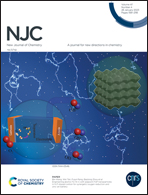Using phenylphosphinic acid/zinc hydroxystannate nanoparticle-decorated graphene to enhance the flame retardancy and smoke suppressive performance of epoxy resin†
Abstract
To improve its dispersion and flame retardant efficiency, graphene oxide (GO) was modified multiple times with functional elements and the graphene-based flame retardant was endowed with catalytic carbonation ability to reduce flammability and smoke suppression of epoxy resin (EP). The graphene-based flame retardant (MZP-GO) was successfully synthesized by incorporating functional elements (phosphorus, zinc, tin, and molybdate) into graphene oxide nanosheets. Subsequently, the resulting MZP-GO was added to EP to prepare EP composites. The MZP-GO showed well-dispersed behavior in the EP matrix. After adding 2 wt% MZP-GO to the EP matrix, the fire test results showed a significant reduction in heat and smoke. Compared with pure EP, the EP composite shows a 62.9% reduction in the peak heat release rate and a 52.7% smoke production rate. Moreover, the limiting oxygen index value was improved from 25.4% to 29.7%, and the sample could easily pass the UL-94 V-0 rating. This study provides a novel strategy to fabricate high-performance flame-retardant polymer materials with expandable practical applications.



 Please wait while we load your content...
Please wait while we load your content...